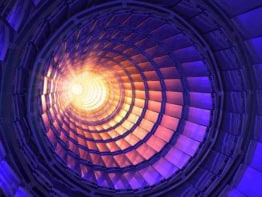Physicists in the US have observed parity violation in collisions between electrons for the first time. The results, which are in agreement with the Standard Model of particle physics, also provide a new measurement of the weak charge of the electron (P Anthony et al. 2004 Phys. Rev. Lett. 92 181602).
An interaction conserves parity if it does not change when all three directions in space are reversed. Parity is conserved in three of the four fundamental forces — gravity, the electromagnetic interaction and the strong force — but not by the weak interaction that is responsible for radioactive beta-decay.
In the E158 experiment at the Stanford Linear Accelerator Center (SLAC), a high-energy beam of electrons was fired at a liquid hydrogen target. The beam was polarised with the spins of the electrons either pointing in the same direction as the beam (so-called right-handed polarisation) or in the opposite direction (left-handed polarisation).
The E158 team then measured the rate at which these electrons bounced off electrons in the target and calculated the difference, or asymmetry, in the scattering rates for right- and left-handed electrons. The difference was 175 parts per billion, with statistical errors of 30 parts per billion, making it the most precise measurement of asymmetry in an electron scattering experiment to date. Using this result, the team calculated the weak charge on the electron — which is a measure of the strength of the weak interaction between two electrons — to be -0.053 plus or minus 0.011. This agrees well with the Standard Model prediction of
-0.046.
However, the values of various parameters in the Standard Model determined by the team are not yet as precise as those obtained in electron-positron collisions at higher energies, and the E158 team now plans to reduce the uncertainty in its experiment to 10 parts per billion.



